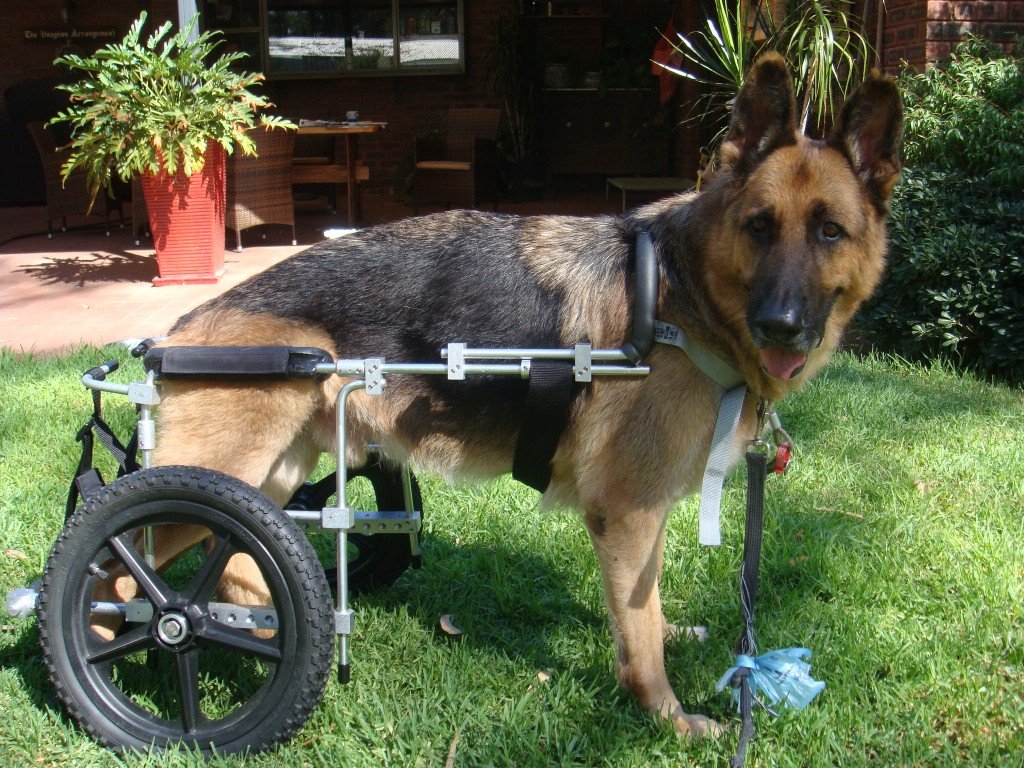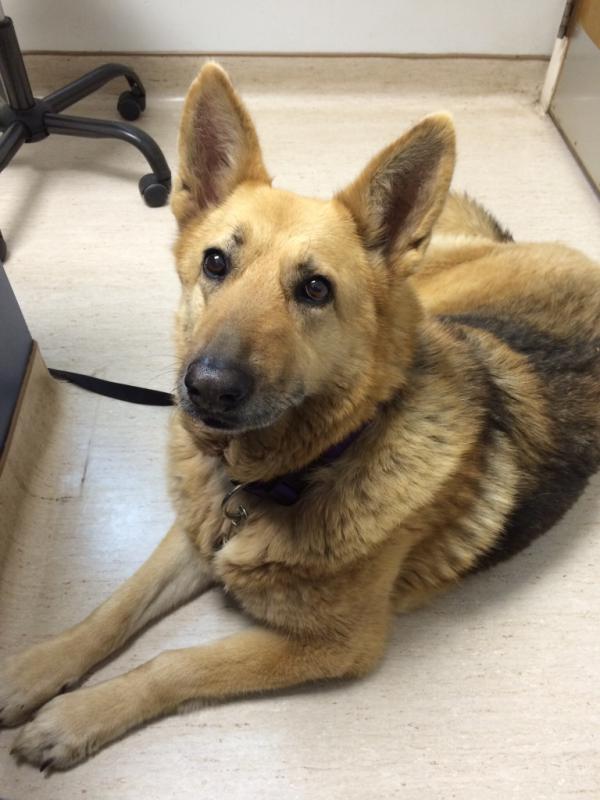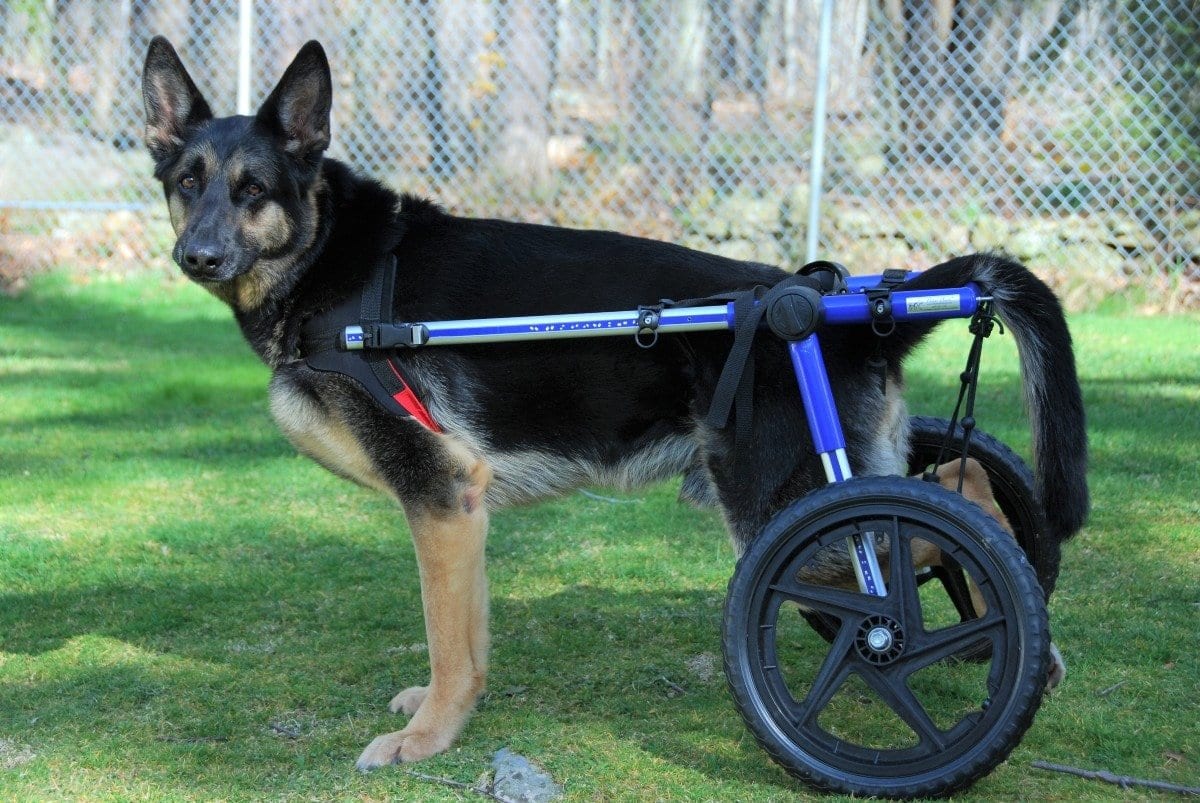Causes Of Degenerative Myelopathy
While the leading cause of degenerative myelopathy is unknown, there have been speculations that it is caused by certain dogs genetic or DNA makeup. When it was first discovered, it mainly affected German shepherds and veterinarians referred to as German shepherd degenerative myelopathy. However, later on, it was found in other breeds, and the only common thing was the age of the dogs.
What Is The Prognosis
Unfortunately, degenerative myelopathy is a progressive, incurable disease. Although bladder and bowel control are not affected initially, as the spinal cord continues to degenerate, the dog’s mobility becomes severely restricted and it has more difficulty controlling urination and defecation. The nature and temperament of the affected dog determines whether or not a mobility aid such as a paraplegic cart will improve its quality of life in the short term. However, the inevitable progression of this degenerative condition means that the symptoms will worsen over time. Your veterinarian will assess your dog’s circumstances and help you determine the most appropriate treatment options for your pet.
How Is Dm Diagnosed
This disease will be suspected on the basis of breed, medical history, physical examination, and diagnostic tests. X-rays and other spinal imaging techniques will rule out other problems such as hip dysplasia and chronic arthritis, most often during the initial stages of DM. If one of these other problems is also present, it can contribute to the patient’s loss of function of the hindquarters. Other tests that may be conducted include cerebrospinal fluid analysis, tissue biopsies and neuromuscular tests such as spinal cord evoked potentials. DNA testing for the SOD-1 mutation is recommended in any at-risk breed displaying clinical signs consistent with DM. Histopathology of the spinal cord is required for definitive diagnosis of DM. The diagnosis of DM is a challenging, often a time-consuming endeavor requiring many tests before a definitive diagnosis is made.
You May Like: Where To Buy German Shepherd Husky Mix
What Are The Common Signs Of Degenerative Myelopathy
The first signs of degenerative myelopathy generally develop at around eight years of age, although the onset may be later in life in some dogs. Weakness and loss of co-ordination in one or both of the hind limbs is often the initial sign, followed by dragging and scuffing of the digits . Affected dogs have a drunken appearance and will often stumble and fall when turning, especially on slippery surfaces. As the condition gradually progresses over many months, hind limb weakness and loss of co-ordination increase. In some severe cases the fore limbs also become affected and affected dogs can become unable to walk and may develop incontinence. Degenerative myelopathy is not a painful condition and, as a result, affected dogs are generally well and keen to exercise, despite their disability.
A German Shepherd Dog with degenerative myelopathy the hindlimbs are weak and inco-ordinated, and the toes of the right hind paw are being dragged.
Mapping The Dm Locus And Identification Of A Sod1 Missense Mutation

Mapping of a major DM locus. GWA of 49,663 SNPs by using 38 cases and 17 controls from Pembroke Welsh corgis identified a major locus on CFA31 and weaker signals on other chromosomes by using 10,000 permutations in PLINK . The CFA31 region of association spans â1.5 Mb and includes SOD1. P values from fine-mapping with 90 SNPs in 63 cases and 144 controls from 5 breeds are shown as well as the association for the missense mutation, which was separately assayed. Fine-mapping data shows that a 195-kb haplotype surrounding the SOD1 mutation is associated in all 5 breeds and that this haplotype is older than the SOD1 mutation.
Recommended Reading: How Big Is A 3 Month Old German Shepherd
Common Problems With German Shepherd Back Legs
German Shepherds are a dog breed that is often mentioned when it comes to mobility issues especially in their older years. Mobility is an important consideration when it comes to taking care of your dog. Not only does it affect most of the normal daily activities that the dog is able to perform, but mobility issues can affect the dogs mood, appetite, and quality of life. Therefore, in this article, we explore some of the common German Shepherd back leg problems.
Histopathology Immunohistopathology And Electrodiagnostic Testing
Standard procedures were used for histopathology, immunohistopathology, and electrodiagnostic testing as detained in SI Methods. Samples used for SOD1 immunohistochemistry were coded, and micrographs of spinal cord motor neurons were obtained in a masked manner. A second masked evaluator classified the neurons in the micrographs according to the presence and appearance of SOD1-positive inclusions based on the following categories: well-defined dark staining clumps, well-defined light staining clumps, poorly defined light staining regions, and no staining or diffuse light staining similar to the background staining 6 to 9 sections from each cord were examined.
Recommended Reading: How To Know If German Shepherd Is Pregnant
The Test Gives Pet Owners The Following Information:
What Causes Canine Degenerative Myelopathy In Dogs
Degenerative Myelopathy is a crippling disease that causes progressive paralysis in many dog breeds.
Although it is certainly a terrible disease that no pet owner would want for his or her dog, it isnt always painful.
However, the dogs quality of life is certainly affected.
Degenerative Myelopathy first affects the spinal cord. The area of the spinal cord that is affected by the disease is detected by white matter, which is present under a microscope. The white matter consists of fibers that affect the brains commands to signal movement as well as sensory information.
These fibers can also impact the cerebrospinal fluid, which is the natural liquid surrounding the spinal cord and brain. Over time, the degeneration process takes over.
Recommended Reading: Who Would Win In A Fight German Shepherd Or Pitbull
Diagnosing Degenerative Myelopathy In Dogs
The initial symptoms of degenerative myelopathy can look like other diseases so a full physical examination and often some diagnostic testing must be performed to rule out other causes of hind limb weakness. A full medical history along with the consideration of the breed and age of the dog will also be taken. Diagnostic tests such as X-rays, CT scans, MRI’s, and cerebrospinal fluid analysis may be performed as well but a biopsy of the spinal cord is the only way to truly diagnose DM. This is not commonly performed though and the diagnosis of DM is typically made after ruling out other potential diseases.
What Are The Clinical Signs
Early clinical signs include:
- The hind paws “knuckle” or turn under so that the dog walks on its knuckles, especially when turning.
- The dog’s hindquarters appear to sway when standing still.
- The dog falls over easily when pushed from the side.
- The hind feet seem to scrape the ground when walking and sometimes the top surface of the feet become hairless and irritated from repeated trauma.
- The dog has difficulty getting up from a lying position.
As the condition progresses and the spinal cord deteriorates, these symptoms worsen, eventually progressing to paralysis of the hind end.
Don’t Miss: Pitbull And Rottweiler Fight
S And Prospects For Elimination Of The Problem
Currently there is no scheme in place to try to eradicate DM from the GSD breed in the UK, although in the USA the University of Missouri and the Orthopedic Foundation for Animals offers a test that can identify the condition and individuals at high risk of developing the disease and/or who are unaffected by the disease but can pass it on . The researchers who developed this test believe that careful use of it could help decrease the incidence of DM in affected breeds although they feel this occurs slowly, over many generations .
Elimination of a recessive gene with incomplete penetrance from a breed is not straightforward if its prevalence is high because removing all carrier animals, that possess a copy of the gene, may significantly affect the number of animals suitable to breed from, and hence the size of the gene pool. Careful breeding of carrier animals to known healthy non-carrier individuals is recommended , with slow replacement of carrier breeding animals with non-carriers over time.
How Veterinarians Diagnose Dm

Veterinarians make their diagnosis based on your dogs symptoms and by ruling out other conditions, like the ones mentioned above.
The only precise way to diagnose the disease is by examining the spinal cord after an animal passes away.
If your vet suspects DM the diagnosis process will probably begin with a physical exam and a basic neurological exam. Blood work and X-rays are also routinely ordered.
Many dogs are then referred to a veterinary neurologist where they undergo a thorough neurological assessment along with a CT scan or an MRI. These powerful imaging tests examine the layers of the spine. Theyre valuable tools to rule out other disorders.
Recommended Reading: How To Build A Whelping Box For A German Shepherd
Intensity Of Welfare Impact
DM is itself not a painful disease however, affected dogs may be caused distress by being unable to function or behave as normal. Trauma may also occur to nails and the skin of the hind limbs as sensation and loss of function progresses. Once paralysed, these dogs have long-term care needs which many owners find difficult and some dogs will be euthanased because of this. Deciding whether these dogs should be euthanased or if they have enough quality of life to justify being supported with paralysis and possible incontinence is an ethical dilemma some dogs and owners do seem to manage successfully with hindlimb carts which support the rear of the dog, for a period of time.
Ultimately, when earlier euthanasia is declined, DM leads to an inability to carry on any kind of normal life and finally to death.
What Is The Outlook For Dogs With Degenerative Myelopathy
Degenerative myelopathy is a progressive condition with affected dogs gradually becoming incontinent and losing the ability to walk. This typically takes place over a 12 to 18 month period from the time of onset of signs. Unfortunately on welfare grounds it is often necessary to consider putting severely affected dogs to sleep .
We are always happy to discuss any aspects of a case with you or your vet prior to referral.
If you have any queries or concerns, please do not hesitate to contact us.
You May Like: German Shepherd Black Long Hair
Dog Breeds Most Prone To Canine Degenerative Myelopathy Dm
Some dog breeds are at a higher risk of developing DM. The most common are the Welsh Corgi and the German Shepherd.
In fact, the spinal cord disease is often referred to as German Shepherd Degenerative Myelopathy since it is most common in German Shepherd dogs.
Here is a list of the most common DM dogs:
- German Shepherd
- Some pain or discomfort in the hind limbs
If a dog has arthritis, it can eventually develop into Hip Dysplasia.
However, one of the most distinguishable signs of DM in dogs is that a dogs hind limbs and rear legs become significantly weaker over time. Dogs will begin to stumble, wobble, and fall often. There are also different types and forms of DM in dogs, which include:
- Spinal injuries, such as spinal stenosis
- Lumbosacral stenosis
- Cervical spondylotic myelopathy
- Discospondylitis Myasthenia
How Do You Diagnose Degenerative Myelopathy
One of the hard things to do is come up with a sure diagnosis of degenerative myelopathy. There are ways that the veterinarian can use to eliminate other conditions, and then you are sure that your dog has DM. The vet will take x-rays of your dogs spine and might also do a spinal tap and have it tested. Despite all this, degenerative myelopathy is only fully diagnosed after the dog dies and the doctor gets to see the dogs spine.
Don’t Miss: How Much Do You Feed German Shepherd Puppy
Good Breeding Practices To Prevent Dm
Because Degenerative myelopathy is an inherited disease, victims can be limited through responsible breeding practices.
If youre planning to add a puppy whos prone to the disease, ask the breeder about the history of DM in the dogs lineage.
Good breeders are proactive and remove a dog from the breeding pool when their DNA test shows theyre in the At-Risk category.
Symptoms Of Degenerative Myelopathy
As is often the case with diseases, degenerative myelopathy is a condition that comes with different stages.
In the early stages, the symptoms of this condition are not severe, but as the condition worsens, they become more serious, and a lot more difficult to live with.
There are 3 stages of degenerative myelopathy they are early, intermediate, and late. So, lets take a look at the symptoms of this condition throughout these different stages.
Also Check: What Size Dog Collar For German Shepherd
Progression Of The Disease
DM slowly attacks a dogs central nervous system by stripping away the protective coating called myelin. This leads to a breakdown of the white matter in the spine which controls movement.
As the white matter deteriorates, less commands about mobility are received from the brain to the limbs and fewer physical sensations are sent from the limbs to the brain.
Degenerative Myelopathy In German Shepherd Dogs

Today many diseases are known and treated, which may or may not be generative, which is better to treat as soon as possible. One of these is degenerative myelopathy, which is seen in dogs preventing them from walking freely or doing other activities. It should be noted that this disease can also occur in cats, and it begins to shed symptoms between the ages of 3 and 14 years. Although these symptoms can also be seen in younger animals, they can be serious if not treated quickly.
Today many articles allow you to improve this condition in affected dogs or animals considerably. However, it is essential to know all the necessary information in this summary and the most recommended optimal treatment methods. Keep in mind that diet is a key factor in this care, so you must have even the necessary vitamins for its care. Considering these considerations, you will be able to deal with degenerative myelopathy in your dog in the best way, helping him improve.
Don’t Miss: Is A German Shepherd A Hypoallergenic Dog
Potential Dangers Of Poor Eating Habits
Excess weight might not be the cause of joint dysplasia, but it certainly can influence it. Imagine you have pretty severe arthritis in your knees, to the point where it can be painful to walk. Now imagine being forced to wear a backpack full of rocks, and how much worse it would feel if those knees had to support that extra weight also. For the normally very active German Shepherd, excessive weight can be a serious issue.
Rapid growth during puppyhood can contribute to poor bone formation, in addition to hereditary genetics.
- Though it doesnt fall under the realm of back problems, Bloat is thought to result from rapid eating. Because the animal is eating so quickly, it can swallow gasses that accumulate in the stomach cavity, causing it to expand and potentially twist. The twisting will cut off blood supply to the tissues, leading to organ death. GDV is always a medical emergency requiring surgical intervention, and very often fatal.
- Consider purchasing a sectioned-off food dish to force your pup to slow down, or place a large paperweight in the center to separate food.
What Is German Shepherd Degenerative Myelopathy
Contents
Degenerative myelopathy of the German shepherd is a progressive disease of the spinal cord in advanced age dogs. This pathology begins at eight years of age, and a great alert is the dogs coordination to perform basic movements such as running or simply walking.
This disease is easy to identify since the dog tends to fall a lot on its hind legs, even dragging one or both legs when walking. Symptoms can begin with one hind limb affecting the other, reaching the thoracic limbs, progressively increasing the limbs weakness.
Although the dog will have difficulties keeping up, it is not a very painful disease and mostly affects the animals defecation a lot. Although there is still no treatment to reduce or stop this disease, there are measures that help these dogs maintain a lifestyle without problems.
It is also important that the animal perform rehabilitation exercises maintaining lifestyle habits at home that avoid developing pressure ulcers. In this way, you will also be indirectly avoiding problems with an infection in the urine or the progressive loss of mobility.
It should be noted that the rehabilitation sessions will undoubtedly help to delay this degenerative disease by helping to control secondary pain. Remember that this disease will cause atrophy, increasing muscle mass loss, so it is necessary to preserve the forelimbs function.
Also Check: German Shepherd Too Skinny